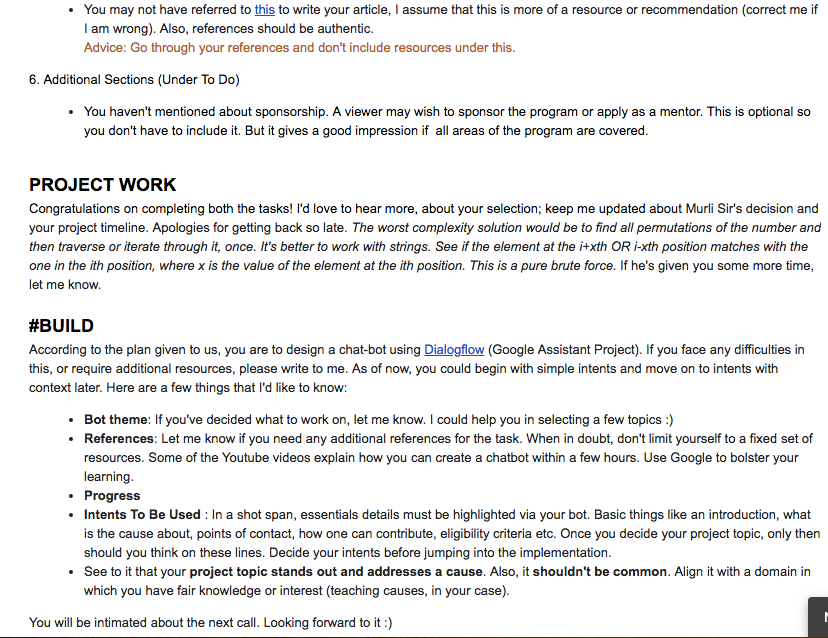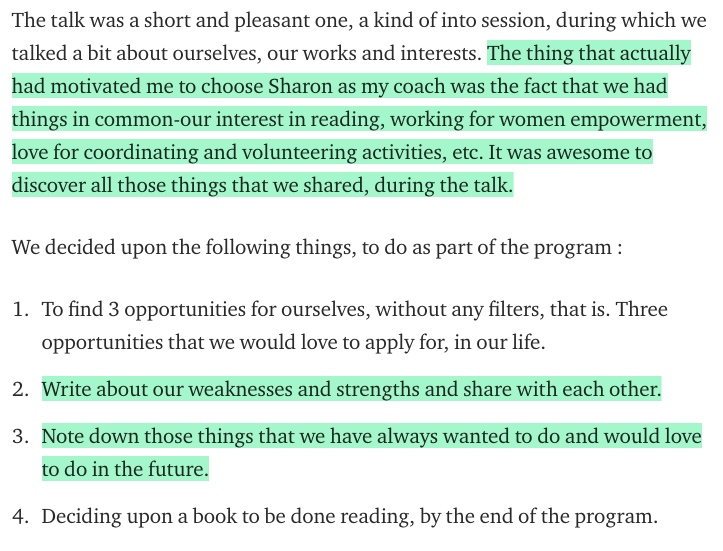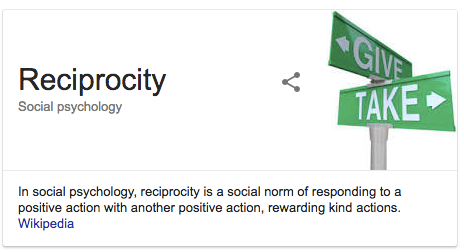Coaching approaches that worked and left an impact on the WIT Cohort 1 students.
Dear WIT Cohort 1 Coaches,
Last week, we had the WIT Participants pick their coaches and have their first call with them. Some of you have one coaches, some two. And most of you managed to have your very first intro call with your mentees too!
Kudos to the time, commitment and effort on your part. All the participants who got on the call were asked to pen down their learning from their interaction with you. Almost all have managed to make the submission as well.
It looks like each of you picked up very different styles and approaches in coaching the participants and all of these approaches have their merits too. This blog post is to share the best approaches adopted by our coaches and why it worked with the participants.
The idea behind this article is to bring to light successful coaching approaches and also spark inspiration in adopting them. Read on for more 🙂
Sukriti’s Approach
The communication Sukriti maintains with her mentees during the call and outside the call are both fantastic!
Last week, soon after confirming her mentees, Sukriti sent them this email.

Summary of activities and call to action before the call
The quick summary that she gave conveyed that she was well updated with the work that her mentees were doing. She specifically requested to see their submissions so she could offer feedback and also mentioned that she can be approached if the girls have any challenges with their tasks.
The nudge she gave at the closing of this email — encouraging the girls to ask her about her experiences even outside the scope of the program conveys that she is open to a long term mentoring relationship with them. This also nudges the participants in being more candid and open with her.
Sharing pointed, personal feedback during the call
During the call, Sukriti shared a deck to convey her share of learning and experiences around the activities related to self-branding that the girls already completed. (Website and intro video).
In addition to this, she added a slide with one-on-one feedback for her mentees to improve what they have already done. This single approach of hers is gold.
Why because our attempt with these activities is to give these girls a head start. As the program anchor, my effort is to ensure that they start working along the lines of our program structure and publish a basic version of their work in a defined time period. The girls are expected to continue improving their existing work and your one-on-one feedback will help them make progress in that regard. Given that you will also be spending considerable amount of time with them, in getting to know them, their aspirations, skills, strengths, weaknesses and concerns, you stand well positioned to offer pointed, constructive and relevant feedback so they can improve upon the first version of their work.
Summary after the call
Soon after the call, Sukriti sent across a summary of her call with her mentees. While the mentees may have taken notes during the call, this approach, where the mentor shares pointed summary soon after the call ensures that the time spent together during the call is spent in discussing and interacting with each other instead of the mentees hurriedly taking down notes.
Find below the deck Sukriti shared as summary of their call. The deck included the pointed feedback she shared with her mentees.
Feedback and Call to Action at start of the week
What you can see below is segments from Sukriti’s update email for this week. She has begun the email on an encouraging tone, appreciating the mentee’s efforts. Do note that she has encouraged “regularity and effort” of the mentee. This goes a long way in letting them know that irrespective of your skill level and the outcomes you’ve achieved, you putting in consistent effort is what is desired.
Soon after, she has reviewed the work done by her mentee and again, listed very pointed feedback on the areas she thought they could improve.

She has gone on to comment on a project work that her mentee has undertaken outside of this program. This again, shows that she is keen on helping out the mentee in areas not limited to the program.
Finally, she has given suggestions and thoughts on how her mentee should approach the upcoming activity.

Overall, Sukriti is on her toes and ensures that she keeps her mentees on their toes as well. She holds them accountable in a very beautiful way and offers extremely pointed, actionable feedback. Rather than having a lot of exploratory talk or giving broad feedback such as “Be confident” or “Emphasise on learning”, she gives very specific points on how each of her mentees can actually do that.
Constant, proactive communication on her part, at all times also ensures excellent engagement!
Ayushi’s approach
Ayushi has a very friendly, warm approach towards her mentees. Ayushi brings the aspirations of her mentees into picture and then ties her learning and experiences in helping her mentees.
Mridula, one of her mentees aspires to work in Google and Ayushi has given her clear directions and information on how she must proceed in order to make to Google. What is also great is Ayushi having a more light-hearted conversation with her mentee about her work at google and all the fun things she gets to do.

Such experience sharing gives a more realistic expectation to the students and goes a long way in helping them understand what to expect. Looks like these little fun nuggets of experience — like her mention of the zumba classes at Google — have increased Mridula’s interest in joining Google!
Sharing specific resources that Mridula can make use of is also a good approach!
Ayushi has gone on to helping her mentee ideate and find relatable reference models to build on top of. Ayushi’s experience of working with a Women in Tech cell at her college is proving to be an inspiration for her mentee to go on and build one in her college as well.

Sharon’s Approach
Sharon has taken her experience and time with her mentee to a different level by requesting her mentee to coach her in return for Sharon’s time 🙂
“I can be your coach, provided you become mine” is her line!
Even in their calls, after having few rounds of personal interactions, Sharon has gone on to designing few activities that both her and her mentee will be looking to do. They will both be sharing the progress of it with each other and improving together.
This is a very friendly, warm approach in getting your mentee to do things and also develop comfort so they open up and let you in.
The activities that Sharon has given are as below:

Now here, while these seem like very small tasks, what Sharon has managed to do is be open to share her own aspirations, strengths and vulnerabilities with her mentee in return for her mentee also doing the same.
If Archana was the only one discussing her concerns or aspirations, there might have been room for discomfort to develop, especially when opening up about sensitive issues.
Sharon has managed to bring in Reciprocity into her approach. By taking initiative in opening up, Sharon is nudging her mentees also to reciprocate her actions and do the same. (This is also how we nudge the participants to share their learning on a blog — They give what they take or they pass on the knowledge, guidance and support that they get)

This goes a long way in letting your mentee know that you are also looking to learn from them. (I’m sure there’s a lot to learn from all the participants)

Additionally, Sharon’s message to her mentee is to “Keep Trying”, again reinforcing the importance of them doing things and figuring it out.
Amrita’s Approach
Amrita’s approach is again, friendly on the whole. One great thing she does while sharing her tips and suggestions is taking the lead in addressing a concern her mentee might have.
You can find below the key take-aways of her mentees:

If you look at point 2, 3, 4, there’s a difference in the way Amrita has positioned the message.
Point 2 — Instead of saying “Work on it for at least a week”, she added that you have work on something long enough before deciding to give up. Now Amrita here has made her mentee comfortable with the idea of giving up on a project if she does not find it interesting enough BUT only after working on it for a considerable amount of time. By discussing this challenge that her mentee might face upfront, having her prepared to face it and by leaving her with a thought process to stick to when in doubt, she has really equipped her mentee to deal with her inner demons on her own.
Point 3 — Amrita has probably stolen words right from her mentees thoughts — By first discussing a vulnerability that her mentee may possess upfront, she has eliminated that from creeping into her mentee’s thinking. And instead of just addressing it, she has also gone on to providing a solution to it.
Another great thing about Amrita’s approach is discussing about her mentee’s aspirations and immediate plans and offering suggestions/resources to help her out. Notice how Amrita suggested InOut Hackathon to Liyana.

Sethu’s Approach
Sethu started off by sharing her personal experience of attending GHCI, which her mentee also aspires to attend. By building on shared interests, Sethu has developed a good rapport and comfort with her mentee right away!
Sethu’s initiative in opening up her connections and network to her mentees is brilliant. By mentioning other smart girls her mentees should look up about, she has nudged her mentees to find more relatable role models, connect with them.

Subsequent to this, Sethu has mentioned the importance of having a neat LinkedIn profile — tying in to our initial activities on #Self_Branding.
Paavini’s Approach
Paavini has gone on to giving her mentees small assignments along their areas of interest. Both her mentees are looking to make more Open Source Contributions. Along with sharing her thoughts and experience on open source contributions, she has nudged them to actually get started with something and move the needle by next week.

Amalu’s Approach
Helping her mentee see her strengths is the key take-away from Amalu’s approach. Amalu uses the experiences that her mentees have already had to remind them of their strengths and capabilities.

Fausya’s and Lavanya’s Approach
Fausya talks a lot about her Firsts. The first time she applied, the challenges she faced then and how she navigated them. This makes the girls find her very relatable. They see a bit of themselves in that old Fausya and finally end up feeling that they can also manage to improve if Fausya could improve.

Lavanya on the other hand, clears common misunderstandings that her mentees have by quoting her own example. I’ve also noticed that the girls have some unrealistic expectations about what a scholar or recipient of these opportunities should look like. They index themselves with this unrealistic expectation. Busting their myths on who an ideal candidate is or what she looks like is a good start to nudging them to accept themselves as they are and focus on improving their skills.

Final Thoughts
While our girls are super smart and talented, some of them are truly confused souls. A lot of them mentioned the possessed “Imposter Syndrome” in their applications or interviews. Why is that so? Honestly, I do not know.
But whatever it is, it really is upon us to make use of the time we have with them to mould them into confident, bold young women who can and will take on the world.
As a general approach, making our vulnerabilities visible to them, letting them know about how we managed to get where we are, sharing our first experiences, mistakes will help them understand they are talking to living, breathing, real human beings, just like them. That all of this is doable and to some extend is also a skill, not a superpower you are born with.
Providing very specific, actionable feedback on how they can improve will really help them. As discussed, the program will ensure that they get started but your feedback, help and support will help them improve upon the things they are just getting started with.
Opening up your learning, resources and network to help your mentees inch closer to their aspirations and goals is your mark or showing leadership and care for them.
There is no right way to coach. Each person has their own style. But being mindful of the little things, being warm and approachable, making it more about them and providing actionable feedback on how they can improve should really be our focus.
Lastly, I absolutely urge you all to not feel pressured to know it all, to be able to answer every query or concern that the girls have and to also be open towards learning as much as you can from the girls, your fellow coaches and also this entire experience.
So far so good. given that the girls are absolutely outperforming our expectations, it may be time to step up our game as well to match their energy and enthusiasm 🙂
More power to each of you!